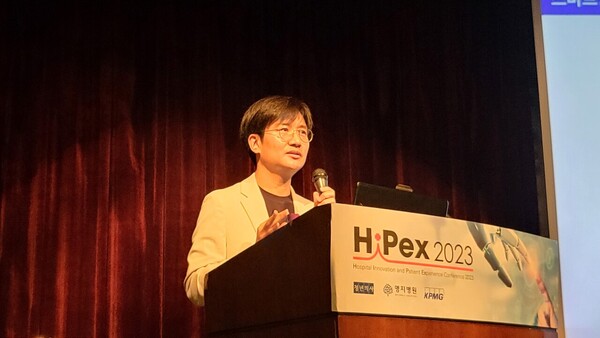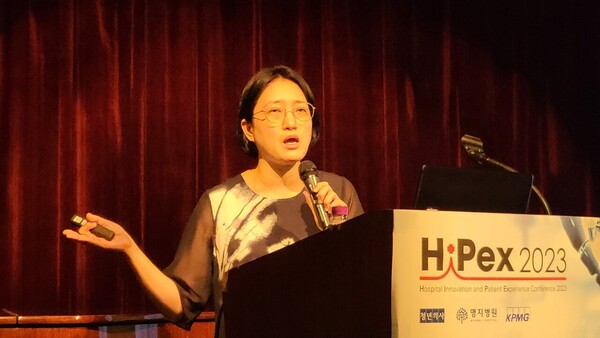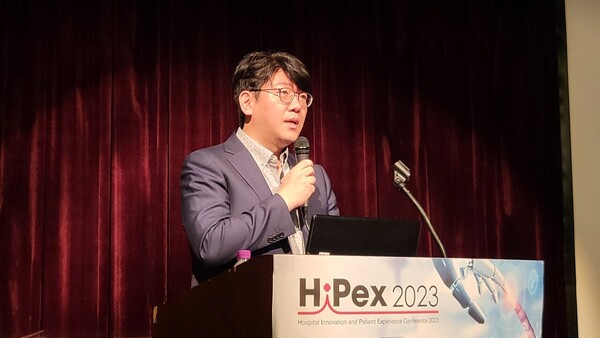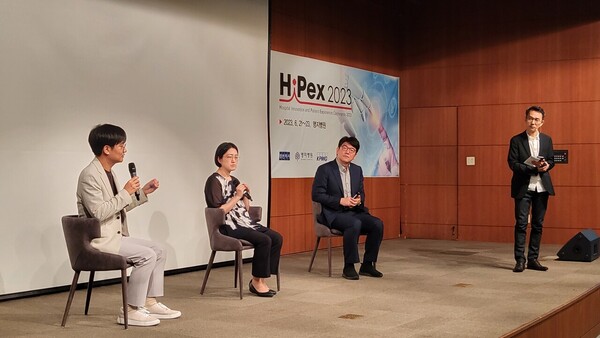What robots are medical institutions using, and how?
At the Hospital Innovation and Patient Experience Conference 2023 (HiPex 2023), which opened at Myongji Hospital in Goyang. Gyeonggi Province, on Wednesday, participants highlighted the status and potential of robotics in healthcare organizations, focusing on the cases of Yongin Severance Hospital, Hallym University Sacred Heart Hospital, and Samsung Medical Center.

Yongin Severance Hospital has actively used robots since its opening in 2020. Dr. Park Jin-young, a psychiatrist and director of the Digital Healthcare Industry Center, introduced the use of robots under the theme of “The story of a new medical service robot entering the hospital.”
Yongin Severance Hospital uses 10 medical service robots, including a guide robot, a transfer robot, an operating room transfer robot, and a weight transfer robot.
To use “new” robots more efficiently, the hospital gave names to robots in each department so that they could be considered part of the department.
As a result, the guide robot was named “Annaegun” and “Annaeyang,” the blood transfer robot was named “Labbie,” the kid's robot, “Kirini,” the nursing cart robot, “Seonseoni,” the bellhop robot, “Jim Carry,” the medical supplies transfer robot, “Narcia,” the surgical tool transfer robot, “Gisongi,” the medicine transfer robot, “Piyong,” and the sample transfer robot, “Yisongi.”
"The principle of using robots in hospitals is that (all robots) should be well networked and analyzed," Park said. "It should not be technology for technology's sake. It should be technology that blends in medical fields.”
It is also important not to overestimate robots. Even if the robot is autonomous, it cannot go through a fire door, and it has to be connected (to an elevator), he said, adding that it is a difficult job and hospital staff have to create different scenarios to make it move.
"Just as we continue to work on patient experience, we must continue to build on our experience with robotics. For example, kids' robots have effectively alleviated children's fears of medical procedures," he said. "The use of robots in hospitals will allow patients to have multiple experiences."

Hallym University Medical Center operated 28 robots last year, including guidance, delivery, quarantine, and non-face-to-face multidisciplinary robots. It plans to increase the number to 72 this year.
From August 2022 to May 2023, the hospital used robots for 1,374 outpatient guidance, 2,937 deliveries, 5,077 epidemic preventions, 181 video guidance for inpatients, seven non-face-to-face multidisciplinary care, two night-patrols (under test), and 52 home care services.
When asked about their satisfaction with the robot, 73 percent of the hospital’s 63 nurses who used the delivery robot said they were "relieved of simple tasks," 81 percent said they would continue to use the delivery robot, and 89 percent said it was "essential for hospitals to introduce robots.
In a patient satisfaction survey conducted on 82 patients who used the non-face-to-face multidisciplinary robot, 92 percent found the video guidance helpful, 100 percent felt comfortable with the robot's guidance, and 92 percent felt positive about the robot's service.
Based on this experience, Lee Mi-yeon, a radiation oncologist and head of the Command Center at the hospital, advised that hospitals preparing to introduce robots need to; purchase using national projects; select appropriate robots for services and use spaces; build facility infrastructure, such as automatic door interlocking, elevator interlocking, and step construction; and seek cooperation from various departments.
"We can't bring robots into the hospital and give additional work to people with existing jobs. They are burdened with too much work. We introduce robots to reduce workload, so we cannot put more personnel into the process,” Lee said. “It's still difficult to introduce robots in hospitals, but we should try to utilize robots in hospitals (for our future).”

“At Samsung Medical Center, we mainly use heavy-duty transport robots. It's important for staff to know where these robots are and what they are doing,” said Cha Won-cheol, an emergency medicine specialist and head of the Digital Innovation Center at Samsung Medical Center. "Just as patients are getting rid of paperwork when they come to the hospital, robots will also be activated."
He went on to say, “Robotics, AI, and the metaverse are like a trivet. We are trying to figure out how to apply them to clinical practice."
After listening to the experiences of hospitals’ use of robots, the audience asked some questions.
When asked if “there should be a separate department to manage robots,” the presenters said that since robots are also a kind of tool, their management should be handed over to the department that uses them. However, since introduction and maintenance are different, they also said that an organization like the Command Center at Hallym University Sacred Heart Hospital is necessary for the initial introduction phase.
Asked if they had to “choose just one among robots used at each hospital,” all three speakers said that transfer or delivery robots would be a good fit.
To the question of “which kind of corporate robots should be utilized," the three agreed that it's important to work with small- and medium-sized enterprises to customize robots because it is difficult to work with large companies on robotics.
"Big companies don't see hospitals as a market where they can sell robots. And that's my biggest complaint. The robots we use are also used in hotels and casinos, and the hospitals’ needs take a backseat to those at hotels and casinos,” said Lee, head of the Command Center at Hallym University Sacred Heart Hospital.
Lee went on to say, "I sometimes got the feeling that we should gather hospitals interested in robotics and make a jointly signed petition. It's really hard to work with big companies. Hospitals interested in robotics should create an alliance to empower themselves.”
The three speakers said in concert, “We must still go through a tough process to introduce robots in hospitals. It seems as if we must go crazy to do this job. Still, many government initiatives exist, so if you look closely, you can get help."

Related articles
- Naver showcased responsive healthcare AI, what’s next?
- HiPex 2023 to showcase cutting-edge hospital innovations
- Why ‘medical system not squeezing workers’ is innovation in Korea
- ‘It's time to ditch ‘myths’ in perioperative patient care’
- Indonesian officials visit Yongin Severance Hospital to benchmark digital transformation

